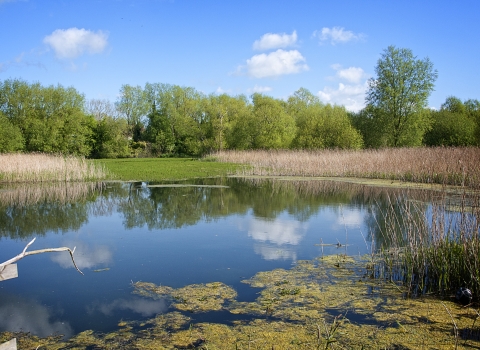Rob Waller
Great Traston Meadows
Please see public notice below regarding ongoing tree works (26/09/2025)
Know before you go
Dogs
When to visit
Opening times
Open at all timesBest time to visit
Spring and summerAbout the reserve
Public notice 26/9/2025: There will be ongoing works at Great Traston Meadows over the next few weeks. If visiting the reserve, please keep your distance from the work areas and not interrupt the machinery operators. We also remind visitors to please keep dogs under control and on leads (as is required on this reserve at all times of the year.)
Landowner, Eastman Plc have contracted independent tree felling, pollarding and clearing works. This is protect and manage hazards of external utilities that run across site, for the overhead powerlines and underground effluent pipeline. For further information contact: Eastmans Newport
About the reserve:
This type of traditional landscape has existed for hundreds of years on the Gwent Levels. The low-intensity management of this land has allowed a rich diversity of plants to flourish and support a whole host of insects including the shrill carder bee, the UK's rarest bumblebee.
The reserve is at its best in spring and summer when the meadows are full of tall grasses, vibrant-pink vetches and yellow buttercups that are joined by a spectacular display of over 5,000 Southern marsh orchids in June and July. The abundance of nectar- and pollen-rich flowers provides a banquet for hundreds of butterflies, bees and other insects, and dragonflies and damselflies patrol the waterways. Autumn and winter is a quieter time but as the meadows become barer it is easier to see some of the more elusive residents, like otters and snipe. As the warmer months return, warblers, swifts and swallows appear to feast on the insects beginning to fill the air once more.
What we do here
Great Traston Meadows is a triumph of teamwork, with Gwent Wildlife Trust working in partnership with the owner, Eastman Chemical Ltd, to manage the site for the benefit of people and wildlife.
To benefit the diversity of plantlife on the reserve, our management regime involves an annual hay cut and low intensity grazing, normally with cattle. We are opening up some of the densely-shaded reens (drainage channels) to improve them for wildlife, such as otter and water voles, and cutting glades into areas of forest plantation around the reserve to provide sheltered, sunny spots for insects.
History
The low-lying land of the Gwent Levels has been farmed and modified for centuries to exploit its rich alluvial soils. The network of grips, ditches and reens that cross the Gwent Levels, and can be seen on the reserve, were handcrafted by man to allow management of the land but now play an important role in the richness of wildlife found here. By continuing the traditional, low intensity management at Great Traston Meadows, we have preserved these features and the diverse plants which thrive in them.
Directions
By car
Exit the M4 motorway at Junction 24 and, at the roundabout, take the exit signposted ‘City centre (A48)'. Stay on this road for approximately 4km until the 5th roundabout. At this roundabout, take the 1st exit onto Nash Road. Continue until you reach a T-junction and take the right turn to continue along Nash Road. After another 500m, you will pass a double-fronted white house on your right called ‘Fair Orchard’. Just after the house, the road will bend to the right and the turning to the reserve is on the right where the pylons straddle each side of the road (grid ref ST 346 843).
Near the reserve
Gwent Wildlife Trust’s Magor Marsh and Peterstone Wentlooge Marshes reserves are close by. The Newport Wetlands National Nature Reserve is a five minute drive away and is a great place to watch wetland and migrant birds.
The Wales Coastal Path passes through the reserve, detouring inland from the River Usk to the west, before continuing on to re-join the coast at Nash in the south. Public footpaths link the reserve to the villages of Nash and Goldcliff that both have pubs offering refreshments.
Habitat
Contact us
Environmental designation
Join us!
Help protect and support our beautiful nature reserves and local wildlife. Join our community of members today!

